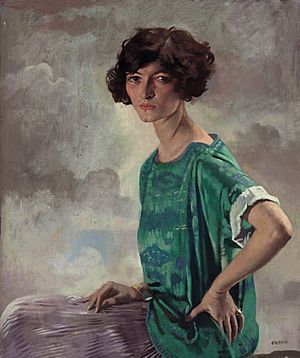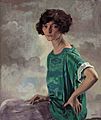Gertrude Sanford Legendre facts for kids
Quick facts for kids
Gertrude Sanford Legendre
|
|
|---|---|

Gertrude Sanford (by William Orpen, 1922)
|
|
| Born |
Gertrude Ellen Sanford
29 March 1902 |
| Died | 8 March 2000 (aged 97) |
| Resting place | Medway, South Carolina, US |
| Known for | Hunter, spy, socialite |
| Spouse(s) | Sidney J. Legendre (1903–1948) |
| Children | 2 |
Gertrude Sanford Legendre (born March 29, 1902 – died March 8, 2000) was an amazing American woman. She was a socialite, meaning she was well-known in high society. During World War II, she worked for the Office of Strategic Services (OSS), which was America's spy agency. But that's not all! Gertrude was also an explorer, a big-game hunter, and someone who cared deeply about nature. She owned a historic place in South Carolina called Medway.
Contents
Early Life and Family
Gertrude Ellen Sanford was born in Aiken, South Carolina. Her father, John Sanford (1851), was a successful rug businessman and a member of the U.S. House of Representatives. Her grandfather, Stephen Sanford, also owned a carpet company and served in Congress. Her other grandfather, Henry Shelton Sanford, was a diplomat.
Gertrude was the youngest of three children. She had a brother, Stephen, who was a famous polo player, and a sister, Sarah Jane. Their lives actually inspired a famous play called Holiday in 1928. This play was later made into two movies, one in 1930 and another in 1938.
Everyone called Gertrude by her nickname, Gertie. She grew up in Amsterdam, New York, and in a fancy house in Manhattan, near Central Park. She went to Foxcroft School in Virginia. After finishing school in 1920, she made her "society debut," which meant she was formally introduced to high society.
Adventures and Expeditions
Gertrude loved adventure from a young age. While still a teenager, she went on her first hunting trip to the Grand Tetons in Wyoming. For many years, from 1923 to 1939, she went on exciting expeditions around the world. She hunted big game and donated rare animal specimens to natural history museums.
Her trips took her to places like Africa, Iran, Southeast Asia, Canada, and Alaska. She was often the only woman on these expeditions. People admired her for her energy, good sportsmanship, and strong determination.
During one of her trips, an exploration of Abyssinia (now called Ethiopia) in 1928-29, she met Sidney J. Legendre. They were both co-leaders for the American Museum of Natural History expedition.
Marriage and Home Life
Gertrude Sanford married Sidney J. Legendre on September 17, 1929, in New York. After they got married, the couple bought a very old plantation in South Carolina called Medway. They made it their home.
Medway was in bad shape when they bought it. Gertrude and Sidney spent many years carefully restoring the house and its grounds. It eventually became a successful place for growing timber.
Gertrude and Sidney had two daughters: Landine, born in 1933, and Bokara, born in 1940.
World War II Service
When World War II started, both Gertrude and Sidney Legendre wanted to help their country. Sidney joined the U.S. Navy. Gertrude worked for the Office of Strategic Services (OSS) in Washington, D.C., and later in London. The OSS was America's spy agency during the war.
Gertrude's job was not to be a spy, but to manage the cable desk, handling important messages. In London, she often hosted important military leaders at her home, even though German "buzz-bombs" (V-1 flying bombs) were a danger.
In September 1944, she was transferred to Paris. She was given a uniform and identified as a second lieutenant. Later that month, she became the first American woman in uniform to be captured in Germany. She was on an unauthorized visit near the front lines when she was caught in German sniper fire.
Gertrude was held as a prisoner of war for six months. She made a daring escape on a train heading to Switzerland. As the train stopped near the border, she ran off, even as a German guard shouted at her to stop. She kept running and gained her freedom.
After the war, Gertrude helped a German SS officer who had been kind to her move to the United States. She also sent food and other necessities to others who had helped her during her imprisonment. She even started the "Medway Plan" to connect American cities and people with those in Europe who had suffered greatly from the war.
Later Life and Legacy
In 1947, Gertrude and Sidney went on another expedition to India to collect specimens for the Peabody Museum of Natural History. Sadly, Sidney died suddenly in 1948 at Medway.
Gertrude continued her adventures. She joined another expedition to Nepal in 1949. In 1952, she went on a final collecting trip to Africa for the American Museum of Natural History. During that trip, she visited the medical mission of Dr. Albert Schweitzer, whom she called one of the greatest men she ever met. Gertrude never lost her love for travel, visiting many countries and even taking a trip around the world with her daughter Bokara in 1962.
In her later years, Gertrude created the Medway Environmental Trust. This trust helps with education and makes sure that her beloved home, Medway, would always be protected as a nature preserve. She also made agreements to protect her historic house and most of her property.
Until she was almost 97, Mrs. Legendre hosted a traditional New Year's Eve costume party at Medway. At one of her last parties, she gave a toast: "I look ahead. I always have. I don't think about life. I live it, and I'm having the time of my life."
Gertrude wrote two books about her life: The Sands Ceased to Run (1947) and The Time of My Life (1987). She passed away at Medway on March 8, 2000, at the age of 97. It was the same day and month that Sidney had died. Her ashes were buried next to his grave at the plantation.
Images for kids


